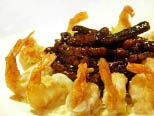Hongniang Zipei
Hongniang Zipei

The dish, literally translated as “the matchmaker finding her own mate,” has its origins in the power struggle between a young emperor and his powerful royal mother.
After Qing Emperor Guangxu ascended to the throne in 1875 at the tender age of four, state power was actually held by the notorious Empress Dowager Cixi. When the emperor grew up, Cixi suggested to Guangxu that he choose some concubines from the older maids in the palace. The intention was to strengthen her position as regent by placing her trusted followers close to the emperor in order to spy on him. Guangxu, however, refused, saying the rule set by ancestors that palace maids were to be released when they reached a particular age had to be observed.
Cixi wouldn’t give up without a fight, and retained four older girls in her company, hoping the young emperor would change mind someday. Among them was Liang Hongping, whose uncle Liang Huiting was a leading chef to the royal family.
Liang Huiting was concerned for his niece’s future, because she was no longer in her prime and staying at court would surely ruin her later life. But being merely a chef, how could he dare raise this with the tyrannous Empress Dowager? Drawing inspiration from Romance of the West Chamber, the story of a couple falling in love without parental approval and eventually getting married with the help of a maidservant named Hongniang, he made a new dish as a tribute to Cixi and named it “Hongniang Zipei.”
Cixi immediately understood the significance of the dish, but instead of appealing to her softer side it made her angry. Knowing punishing the chef would be a public challenge to the emperor, she made efforts to put off the release of the four girls. For three years Guangxu made repeated inquiries into the issue, and Cixi had to compromise at last and let the girls go.
As the dish that helped free the girls from their confinement in the Forbidden City, Hongniang Zipei was considered auspicious and its popularity soon spread outside of court.
To make the dish, you need prawns, salt, pepper powder, Shaoxing wine, minced meat, a batter of egg and flour, a pork fillet and some tomato sauce. Peel and devein the prawns, leaving the tail for their aesthetic value. Cut a slit along the back of prawns, and pat them flat. Marinate these slabs in the mixture of salt, pepper powder, and Shaoxing wine, then wrap them in minced meat to form a semispherical shape. Dip them into the egg and flour batter and deep fry. Meanwhile the pork fillet is sliced and stir-fried in tomato sauce. When both are ready, the prawns are arranged on a plate in the shape of a circle and the stirred fried pork is placed in the middle.
This crispy dish, bringing two types of food together, is pleasing to the eye and very tasty.
Services
Economy
- Eco-agriculture and Eco-tourism Power Nanchang’s Green Development
- Balance Environmental Protection and Economic Prosperity – Nanchang Looks to European Technology for Green Development
- Sustainable Growth Requires Wiser Energy Use
- Chinese Economy: On the Path of Scientific Development
- China's Economy over the Last Ten Years

